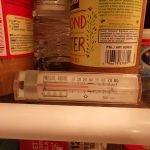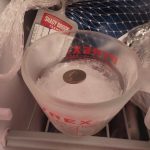
Refrigerator thermometer
I live in an area that may be affected by hurricanes. So, it’s time for us to seriously think about preparing for storms and getting our emergency checklist ready. Even if you don’t live in a hurricane zone there may be other weather situations that may cause power outages and potential food safety problems associated with losing power for an extended time.
Two items I don’t usually see on emergency supply lists are freezer and refrigerator thermometers (these are good to have all year round, not just in an emergency). Place a thermometer in both the freezer and refrigerator. With these thermometers, you can tell the actual temperature the inside these appliances if the power is out. Just touching or thinking they “feel cold” isn’t good enough!
Also, get a tip-sensitive digital food thermometer as they use in restaurants. This will allow you to check the temperature of your food. The best and most accurate way to determine if food is safe to eat is to know its temperature.
I’ve seen postings on the internet about putting a cup of water in the freezer, allowing it to freeze and then putting a coin on top of the ice. The idea is that if the ice melts and the coin sinks you’ll know that the power was out and the temperature in the freezer warmed. (You’d also know that by the condition of your ice cubes and ice cream!) It’s a good concept if you weren’t home when the power went out and now the food has refrozen. Unfortunately, this cup of ice can only tell you that the power was off and the ice melted, it can’t tell you how warm it got inside the freezer. In most cases, if the ice melted, and you weren’t around to take the actual temperature, you’d probably have to pitch most of the food because there are just too many variables and unknowns.
After the power has been out for more than 4 hours you’re going to have to ” break the rule” of leaving the refrigerator door shut, check the temperature, and make some decisions about what to do with the perishable food. Foodsafety.gov recommends, “Food (stored in refrigerator) should be safe as long as power is out for no more than 4 hours. Keep the door closed as much as possible. Discard any perishable food (such as meat, poultry, fish, eggs, and leftovers) that have been above 40 °F for over 2 hours. Never taste food to determine its safety!” See their handy chart here.

Coin in freezer–does this really work?
One more important step in being ready for power outages is to stock foods that can be eaten and prepared without refrigeration or cooking. Canned foods, nuts, snacks, dried fruits, and water can be prepared quickly without opening the refrigerator or freezer door and they require little preparation or clean up. They also come in handy when you don’t have time to go to the store. Don’t forget the manual can opener!
More things to consider: cash, gas, medicines, baby food, pet food, paper plates, cups, napkins, and plastic utensils.
By Cheryle Jones Syracuse, MS,
Professor Emeritus, The Ohio State University
Here is a shopping list for foods that do not need refrigeration along with meal ideas of how to prepare them
Download handout: shop for emergency meals
New Products Available Now
Check out the Nutrition Nuggets page which features over 20% off three special products each week.
Connect with us on Google Plus















